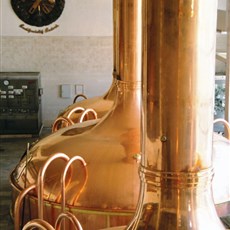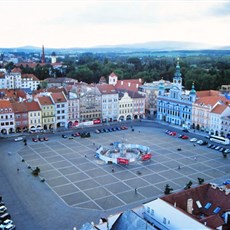1999 Biking East Europe
Thursday, September 23 – Budejovice, Czech
Rep – Vystaviste, 500Kc
Distance cycled: 11.1 – Maximum speed: 25 –
Average speed: 12
Slept until we woke (i.e. no alarm),
showered, washed our clothes, and had a long lazy day.
We cycled to the old town, stopping for a
cappuccino at a café by the river, where we watched mums with kids on bikes or
in prams amble by, people en route to work on bikes, a man in a brown suit on a
bike – altogether a slower-paced lifestyle, at least looking from the outside
in.
Then to the VW shop where Charl set his
heart on adding a Schwimmwagon West to his collection back home. I too did some
shopping, buying four lovely and heavy oil lamps which I left at the shop
promising to collect them after our brewery tour.
We had hoped to eat at the highly
recommended brewery restaurant, but it
had been booked out by a tour group so instead we had something to drink and a
plate of chips at a nearby hotel in the hopes still of eating at the brewery
restaurant after our 14h00 tour (70Kc). We joined several yanks on a beer
pilgrimage and four young Ozzies for the tour. Which was conducted by a young
Czech woman in a short black skirt and jacket who spoke accented and
unnaturally loud English. She was charming, calling us ‘Dear Visitors’ at
regular intervals and making little jokes about peoples’ enjoyment of beer, and
flirting lightly with the men. She showed us the stainless steel fermentation
vats and the maturing tankers (cold) which hold 200 000hl (i.e. 20 million
litres of beer) at a time; the ‘cooking’ process during which water from
special artesian wells, hops and malt are boiled in huge brass bells (stainless
steel on the inside) and where during the sieving process we got a strong whiff
of hops; and the bottling plant – for me the most interesting. There are two
bottling machines in a huge and noisy hall – one handling 45 000 0,3l bottles
per hour, one 40 000 0,5l bottles per hour. Old bottles funnel down a conveyer
belt into a huge cleaning machine and come out the other end sans labels and
tops and presumably cigarette ends. They are then filled with beer and
carbonated and lidded. The bottles are then heated and cooled to pasteurise the
contents and prevent further fermentation and increase shelf life, and then the
labels and gold foil tops are added. The bottles are then crated and leave the
room via a conveyer belt. Our guide mentioned that while the Czechs drink their
beer out of either green or brown bottles, some of the 50 countries to which
they export (they do not export to the USA) will only take brown bottles,
others only green. There has been a Budvar brewery here since 1895, currently
producing five types of typical long-lasting foam beer: light with no alcohol
at all (for ‘drivers’ our guide said), 2.8, 10 (takes 21-25 days) for Ceske Budejovice and
surrounds, 12 (takes 80 days) for export and a strong 17 (takes 120 days).
Had beers with our fellow tourists for
16Kc, got turned away from the restaurant again (too full), and cycled back to
town. To pick up our shopping (car 640Kc and four lamps at 338Kc each). And to
retire to our courtyard pub for drinks and a snack of cold meats and bread. Later
we climbed the 225 steps to the balcony on the 72m black clock tower (built
1553) for great views of the square, the town and the surrounding hills. With
three heavy bells (one about 3800kgs) and an old clock with the workings in a
glass case.
And to end our lovely day, back to our
apple strudel place for a supper of pork cutlet stuffed with bacon and
mushrooms and cheese.

Ceske Budejovice brewery

Ceske Budejovice